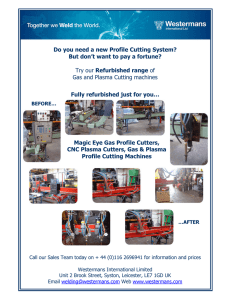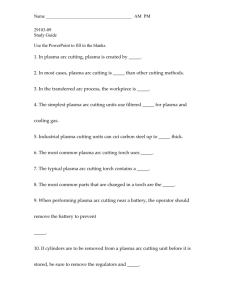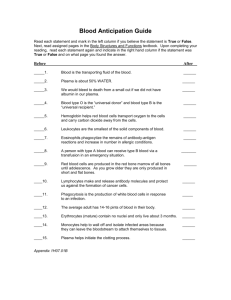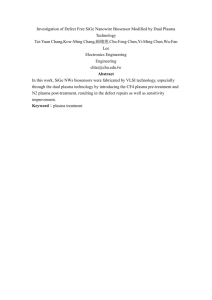Magmate Cut 25 Plasma Machine User Guide
advertisement
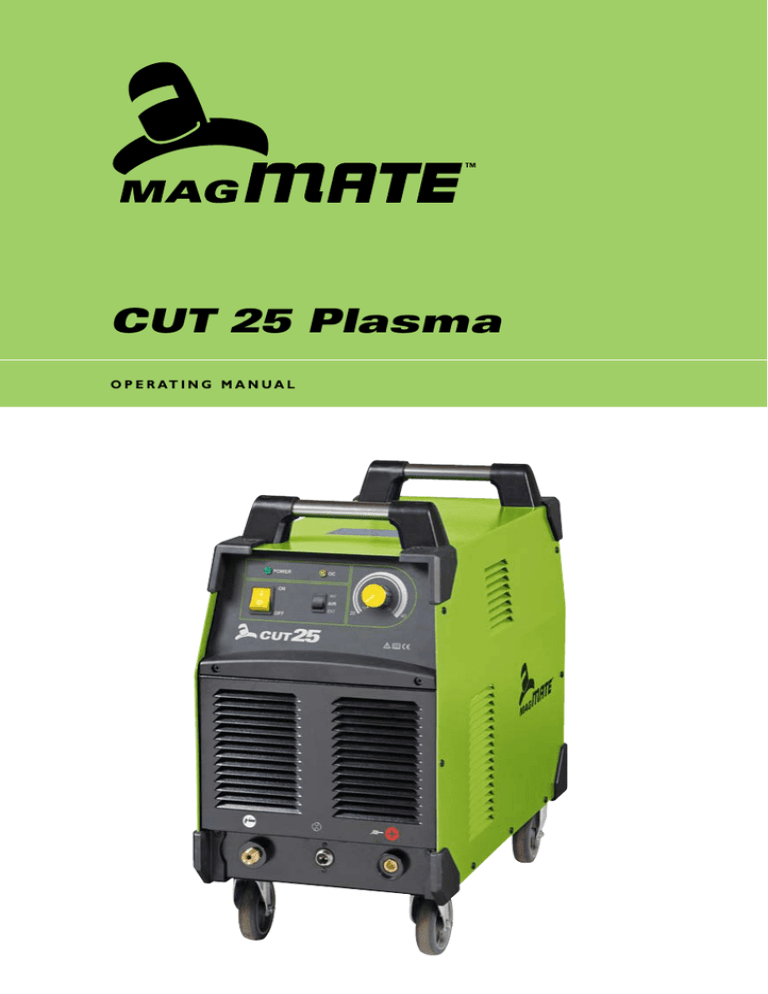
CUT 25 Plasma
O P E R AT I N G M A N U A L
Welcome to a better way
Congratulations on purchasing a MagMate™ Cut25 Plasma.
The products in BOC's plasma cutting machine range perform with reliability and
have the backing of the South Pacific's leading industrial supplier.
This operating manual provides the basic knowledge required for plasma cutting,
as well as highlighting important areas of how to operate the MagMate Cut25
Plasma machine.
BOC equipment and technical support is available through our national BOC
Customer Service Centre or contact your local Gas & Gear outlet.
Important Notice: This document has been prepared by BOC Limited ABN 95 000 029 729 ('BOC'), as
general information and does not contain and is not to be taken as containing any specific recommendation.
The document has been prepared in good faith and is professional opinion only. Information in this document
has been derived from third parties, and though BOC believes it to be reliable as at the time of printing, BOC
makes no representation or warranty as to the accuracy, reliability or completeness of information in this
document and does not assume any responsibility for updating any information or correcting any error or
omission which may become apparent after the document has been issued. Neither BOC nor any of its agents
has independently verified the accuracy of the information contained in this document. The information in this
document is commercial in confidence and is not to be reproduced. The recipient acknowledges and agrees
that it must make its own independent investigation and should consider seeking appropriate professional
recommendation in reviewing and evaluating the information. This document does not take into account the
particular circumstances of the recipient and the recipient should not rely on this document in making any
decisions, including but not limited to business, safety or other operations decisions. Except insofar as liability
under any statute cannot be excluded, BOC and its affiliates, directors, employees, contractors and consultants
do not accept any liability (whether arising in contract, tort or otherwise) for any error or omission in this
document or for any resulting loss or damage (whether direct, indirect, consequential or otherwise) suffered by
the recipient of this document or any other person relying on the information contained herein. The recipient
agrees that it shall not seek to sue or hold BOC or their respective agents liable in any such respect for the
provision of this document or any other information.
­­­2
Contents
1.0 Recommended Safety Precautions
4
6.0 Operating Controls
12
1.1 Health Hazard Information
4
6.1MagMate™
12
1.2 Personal Protection
4
6.2 Package Contents
12
1.3 Electrical Shock
5
1.4 User Responsibility
5
7.0 Air pressure regulator installation
13
2.0MagMate™ Cut25 Plasma
6
2.1 Fundamentals of Plasma Cutting
6
8.0Setting up your MagMate™ Cut25 Plasma
14
2.2Process operation for transferred arc
applications7
Cut25 Plasma
8.1 Fitting the torch to the power source
14
8.2Setting up the power source
15
8.3Selecting the correct air pressure and flow rate
(when using an external air compressor)
15
3.0 Plasma cutting components
8
3.1 Plasma cutting power sources
8
3.2 Plasma cutting capacity
8
9.0 Periodic Maintenance
16
3.3 Plasma cutting torches (general)
8
9.1 Power Source
16
3.4 Air supply
9
3.5 Process comparisons
9
10.0Warranty Information
17
9
10.1 Terms of Warranty
17
10.2 Limitations on Warranty
17
10.3 Warranty Repairs
17
11.0 Recommended Safety Guidelines 18
3.6 Work return cable assembly
4.0 Cutting Technique
10
4.1Cutting
10
4.2 Piercing and Gouging*
10
5.0 Technical Specifications
11
­­­3
1.0 Recommended Safety Precautions
1.1 Health Hazard Information
1.2 Personal Protection
The actual process of plasma cutting is
one that can cause a variety of hazards.
All appropriate safety equipment should be
worn at all times, i.e. headwear, hand and body
protection. Electrical equipment should be
used in accordance with the manufacturer’s
recommendations.
Respiratory
Eyes:
•Wear a respirator when natural or forced
ventilation is not good enough.
The process produces ultra violet rays that
can injure and cause permanent damage.
Fumes can cause irritation.
Skin:
Arc rays are dangerous to uncovered skin.
Inhalation:
Cutting fumes and gases are dangerous to the
health of the operator and to those in close
proximity. The aggravation of pre-existing
respiratory or allergic conditions may occur in
some workers. Excessive exposure may cause
conditions such as nausea, dizziness, dryness
and irritation of eyes, nose and throat.
Confined space cutting should be carried out
with the aid of a fume respirator or air supplied
respirator as per AS/NZS 1715 and AS/NZS
1716 Standards.
•You must always have enough ventilation in
confined spaces. Be alert to this at all times.
Eye protection
Protective eyewear should be worn when
plasma cutting. The minimum lens requirements
are as follows:
Recommended filter shades for
plasma cutting
Arc Current
(Amperes)
Minimum
Protective
Shade
Suggested
Shade*
<20
4
4
20-40
5
5
40-60
6
6
60-80
8
8
80-300
8
9
* One shade darker lens should be used for Aluminium cutting.
­­­4
Clothing
Suitable clothing must be worn to prevent
excessive exposure to UV radiation and
sparks. An adjustable helmet, flameproof loose
fitting cotton clothing buttoned to the neck,
protective leather gloves, spats, apron and steel
capped safety boots are highly recommended.
1.3 Electrical Shock
•Never touch ‘live’ electrical parts.
•Always repair or replace worn or
damaged parts.
•Disconnect power source before
performing any maintenance or service.
BOC stock a huge range of personal protective
equipment. This combined with BOC’s extensive
Gas and Gear network ensures fast, reliable
service throughout the South Pacific.
STOP
PLEASE NOTE that under no circumstances
should any equipment or parts be altered
or changed in any way from the standard
specification without written permission
given by BOC. To do so, will void the
Equipment Warranty.
•Earth all work materials.
•Never work in moist or damp areas.
Avoid electric shock by:
•Wearing dry insulated boots.
•Wearing dry leather gloves.
•Working on a dry insulated floor where
possible.
Further safety information can be
obtained from Welding Institute of
Australia (WTIA) Technical Note No.7
‘Health and Safety Welding’
Published by WTIA,
PO Box 6165 Silverwater NSW 2128
Phone (02) 9748 4443.
1.4 User Responsibility
• Read the Operating Manual prior to
installation of this machine.
• Unauthorised repairs to this equipment may
endanger the technician and operator and will
void your Warranty. Only qualified personnel
approved by BOC should perform repairs.
• Always disconnect mains power before
investigating equipment malfunctions.
• Parts that are broken, damaged, missing or
worn should be replaced immediately.
• Equipment should be cleaned periodically.
­­­5
2.0MagMate™ Cut25 Plasma
2.1 Fundamentals of Plasma
Cutting
A plasma can be created by adding energy to
an electrically neutral gas. In the case of air
plasma cutting the air is dry, clean compressed
air delivered from an air compressor or an air
line. By adding electricity through an electrode
(Hafnium), the gas becomes imbalanced and
conducts electricity. The greater the level
of electricity the higher the temperature of
the plasma.
Typical Plasma cutting set-up
1
2
3
4
5
6
Main power supply
Amperage control knob
Air/Electricity outlet connector
Airflow switch
Plasma Torch
Workpiece
7
8
9
10
11
Plasma cutting torches control energy by
constricting the arc and forcing it through
a constricting nozzle fitted to the torch. By
increasing air pressure and intensifying the arc
with higher voltages, the arc becomes hotter
and more capable of blasting through thicker
metals and blowing away the cuttings, leaving
minimal cleanup.
For plasma cutting, the air supply can be
delivered via an external air compressor or, in
some cases, plasma cutting units (such as the
MagMate Cut25 Plasma) will have inbuilt air
compressors.
Power On/Off switch (on back)
Air pressure regulator
Air compressor (sold seperately)
Air supply hose
Earth lead and connector
1
7
8
2
9 *
10
3
11
4
5
6
­­­6
* Items
sold seperately
2.2Process operation for
transferred arc applications
3
4
1
2
5
1
2
3
4
5
■■
■■
■■
■■
■■
■■
■■
■■
■■
■■
■■
Airflow
Constricted Plasma Stream
Electrode
Constricting nozzle
Workpiece
Compressed air flows through the torch.
A pilot arc is established inside the head of
the plasma torch.
The high voltage of the pilot arc changes the
air stream into a plasma stream.
The plasma stream is constricted and forced
through a tip with a small orifice.
The constricted plasma stream exiting from
the tip is termed a plasma jet.
The plasma jet is allowed to touch the work.
An arc is initiated between the hafnium
electrode and the work.
The arc passes through the orifice of the tip.
The constricted arc so formed is a stiff,
columnated and narrow arc.
The intense heat of arc melts the plate.
The plasma jet blows away the metal to
produce a cut.
­­­7
3.0 Plasma cutting components
3.1 Plasma cutting power sources
3.2 Plasma cutting capacity
The plasma arc cutting power source changes
the relatively high voltage, low amperage
primary power into low voltage, high amperage
secondary power suitable for plasma cutting.
The size of the power source depends on
the cutting amperage it is expected to deliver.
Cutting thicker materials requires more
amperage than does cutting of thinner materials.
Cutting thickness (mm)
Rated Output (A)
Steel
Stainless
Steel
Aluminium
25A Single phase
7
5
3
40A Single phase
9
8
4
60A Three phase
20
18
6
80A Three phase
25
22
8
100A Three phase
32
25
12
160A Three phase
50
35
20
3.3 Plasma cutting torches (general)
Plasma torches are rated in accordance to the
maximum current that the consumable tips
will handle. The diagram below shows a typical
plasma torch with it’s consumable items.
1
2
3
1
2
3
4
5
4
BOC stocks a range of plasma torches and consumables to suit any need.
­­­8
Shield cup
Tip
Air electrode
Standard air plunger
Plasma torch body
5
3.4 Air supply
The supply of air to the cutting process plays
an important role. The force of the air is used
to blow the molten material (created by the
plasma arc) away from the cut area thereby
creating separation. Air pressure and amperage
are two variables that are changed when
increasing the cut thickness.
of the consumable torch parts, it is therefore
recommended that an inline filter drying system
is fitted to all air delivery lines.
When air is supplied from a portable air
compressor it is important to ensure that the
compressor has adequate pressure and airflow
rate capacity.
Typical air supply requirements
Compressed air from compressed air lines may
be contaminated with moisture and oil residue.
Contaminants such as these shorten the life
Pressure
4.5–6 bar
Draw-off rate
150–200 L/min
3.5 Process comparisons
Characteristic
Air plasma cutting
Oxy-fuel cutting
Metals
Any conductive material. Cutting
thickness depends on power source
capacity. Typically very thin to 50 mm
Restricted to steel. The formation of
an oxide during cutting of aluminium and
stainless steel prevents the process being used
Industries
All forms of metal fabrication, art
sculptures, hobby and DIY
All forms of metal fabrication, art sculptures,
hobby and DIY
Pre-heating
Not required
Required on most steel to prevent cracking
Productivity
• Due to the fact that no pre-heating is
required the overall cutting process time
is reduced.
• High speed cutting of thin materials.
• Produces a small, thin kerf width and
minimal post cut cleaning is required
Highly portable and relatively low cost to
set up
Versatility
Highly versatile, stack cutting of
material and combinations of
different materials can be cut.
No additional gas cylinders required
The process can be adopted to welding,
brazing and heating of materials
Safety concerns
Electrical process, therefore a risk of
electrocution exists.
Appropriate safety clothing must be worn
Gas process therefore a risk of flashbacks
occurring leading to explosion of cylinders.
Appropriate safety clothing must be worn
3.6 Work return cable assembly
The work return cable and clamp forms an
integral part of the Plasma cutting process
and if it does not make proper contact the
efficiency of the process is greatly reduced.
It is therefore essential to ensure that the
correct size cable and clamp is fitted to
the machine and it earth clamp is properly
connected to the workpiece to be cut.
­­­9
4.0 Cutting Technique
4.1Cutting
4.2 Piercing and Gouging*
As a general rule for cutting amperages below
40 A the cutting tip can be dragged on the
cutting surface. Higher amperages require a
stand-off distance and torch manufacturers
normally supply a stand-off guide or
'drag shield'. Some operators prefer to use an
extended electrode to improve visibility when
cutting.
To pierce material the cutting torch should
be held at an angle of 45° to the pierce
surface (Refer to Diagram 1 ). Once the arc is
established the torch is turned to 90° (Refer
to Diagram 2 ) and cutting is carried out in a
normal manner. Piercing thickness is dependent
on the output of the machine and is generally
50% of the rated cutting thickness of the
power source.
For straight edge cutting the torch should be
held at a 90° angle to the plate and dragged
along the plate. The cutting speed will depend
on the material thickness, amperage and
airflow rate.
For bevel cutting the torch should be angled
on the plate to the required bevel angle and
dragged on the plate surface. (Note that
the bevel angle will influence the material
thickness).
90°
It is important to direct the arc away from the
operator when establishing the arc as sparks
and molten material will be ejected from the
point of contact. Care must also be taken to
protect the surrounds from these sparks.
1
45°
2
Cutting Direction
90°
* Gouging is dependant on the availability of the correct gouging
tip and the size of the power source.
­­­10
5.0 Technical Specifications
Model No.
MagMate™ Cut25 Plasma
Internal
Air Source
External
Air Source
15–25
20–40
40% @ 25A
40% @ 40A
7
9
Stainless Steel
5
8
Aluminium
3
4
Part No.
MAGCUT25
Input voltage (V)
Single Phase
220V ± 15%
Plug
15A
Input power rating (A)
26
No-load voltage (V)
260
Current range (A)
Output voltage (V)
96
Duty Cycle
Efficiency (%)
80
Insulation class
F
Housing protection class
IP21S
Arc initiation
Contact
Air pressure requirement (bar)
4 (Min)
Cutting thickness (mm)
Mild Steel
Weight (kg)
27
Dimensions (mm)
546 x 272 x 268
­­­11
6.0 Operating Controls
6.1MagMate™ Cut25 Plasma
1
2
6
3
4
5
6.2 Package Contents
• Plasma power source
• Air pressure regulator
• Air hose (3m) and connectors
• Plasma torch
• Work return lead and clamp
• Operating manual
­­­12
7
1
2
3
4
5
6
7
Thermal overload indicator
On/Off switch
Internal/external air supply selector
Air/electricity connector
Contactor
Amperage control knob
Earth return lead (cable) connector
7.0 Air pressure regulator installation
NB:This is only required if an external air
compressor is used.
1
2
3
4
5
6
7
8
An air pressure regulator assembly is included
with the MagMate Cut25 Plasma.
To install follow the steps listed below:
1 Fix the mounting bracket with the screws as
supplied to the back of the machine.
Presure adjusting knob
Mounting bracket
Air inlet connector
Pressure indicating dial
Vapour collection container
Air hose
Vapour drain plug
Outlet marked on regulator
2 Fix the outlet air hose to the air pressure
regulator and the inlet to the machine.
Ensure that all connections are tight.
3 Fit the pressure indicating dial to the main
body of the regulator and ensure that it is
screwed in tight.
4 Fit the air pressure regulator to the
mounting bracket.
5 Fit the air hose (supplied) to the air pressure
regulator inlet and couple to the air supply.
6 Adjust pressure adjusting screw till correct
air pressure is achieved.
1
2
3
4
5
8
6
7
6
­­­13
8.0Setting up your MagMate™ Cut25
Plasma
8.1 Fitting the torch to the power source
A
B
C
A
Rubber boot fitted to the end of the MagMate Cut25
Plasma torch to cover the Air/Electrical outlet. Air/electrical
connection nut B (inside rubber boot).
Incorrect
caution
This is a safety device and must be fitted over the
air/electrical connection prior to use
C Contactor/trigger switch cable connector
Correct
Torch fitted to the MagMate Cut25 Plasma
power source
Warning
Front end MagMate Cut25 Plasma
1 Connect the air/electrical connection B
by fixing the hexagon nut to the terminal
indicated as
. Tighten the nut firmly
but do not overtighten.
2 Important safety notice
Push the rubber boot A over the terminal
and ensure that it is completely covered.
3 Connect the contactor/trigger C switch
cable connector by fitting the plug to the
.
terminal indicated as
4 Fit the work return lead and clamp to the
terminal indicated as
­­­14
.
Care must be taken that the Rubber boot is pushed
over the air/electrical outlet and that all electrical
contact wires are properly insulated as illustrated.
8.2Setting up the power source
1 Connect primary cable to the power supply
(15 Amps).
2 Select the air supply mode (internal/external).
NB: If using an external air supply ensure
that the air pressure regulator is properly
installed as per section 7 of this manual.
3 Connect the work return lead and clamp.
4 Select the appropriate amperage.
6 Begin cutting.
7 The torch is fitted with a trigger safety latch
which needs to be lifted in order to depress
the torch trigger.
8 The cutting process works on the principle
of a contact start i.e. the cutting tip needs
to touch the work piece before cutting will
commence.
5 Ensure that you are wearing the correct PPE.
8.3Selecting the correct air pressure and flow rate
(when using an external air compressor)
Compressed air from compressed air lines may
be contaminated with moisture and oil residue.
Contaminants such as these shorten the life
of the consumable torch parts. It is therefore
recommended that an inline filter drying system
be fitted to all air delivery lines.
When air is supplied from a portable air
compressor, it is important to ensure that
the compressor has adequate pressure and
airflow rate capacity such as the BOC 14 (and
upwards) air compressors.
External air supply requirements for
MagMate Cut25 Plasma torch
Pressure
70 psi / 480 kPa
Draw-off rate
90–100 L/min
­­­15
9.0 Periodic Maintenance
The working environment and amount of use
the machine receives should be taken into
consideration when planning maintenance
frequency of your MagMate Cut25 Plasma.
Preventative maintenance will ensure trouble
free cutting and increase the life of the machine
and its torch consumables.
9.1 Power Source
• Check electrical connections of unit at least
twice a year.
• Clean oxidised connections and tighten.
• Inner parts of machine should be cleaned
with a vacuum cleaner and soft brush.
• Do not use any pressure-washing devices.
• Do not use compressed air as pressure may
pack dirt even more tightly into components.
• Only authorised electricians should carry
out repairs.
­­­16
10.0Warranty Information
10.1Terms of Warranty
10.2Limitations on Warranty
BOC provides a warranty for the MagMate
Cut25 Plasma sold by it against defects in
manufacture and materials.
The following conditions are not covered:
• Powersource: Valid for 18 months from date
of purchase.
• Torch: Valid for 12 months from date of
purchase.
• Leads and work return lead: Valid for one
month from date of purchase.
• Non compliance with operating and
maintenance instructions such as connection
to incorrect faulty voltage supply including
voltage surges outside equipment specs, and
incorrect overloading.
• Natural wear and tear, and accidental damage
• Transport or storage damage.
• An authorised BOC Service Agent must carry
out warranty repairs.
The warranty may be voided if:
• Freight, packaging and insurance costs are to
be paid for by the claimant.
• Changes are made to the product without
the approval of the manufacturer.
• No additional express warranty is given
unless in writing signed by an authorised
manager of BOC.
• Repairs are carried out using non-approved
spare parts.
• A non-authorised agent carries out repairs.
• This warranty is in addition to any other legal
rights you may have.
10.3Warranty Repairs
BOC or their Authorised Service Agent must
be informed of the warranty defects, and the
product returned within the warranty period.
• Before any warranty work is undertaken, the
customer must provide proof of purchase and
serial number of the equipment in order to
validate the warranty.
• The parts replaced under the terms of the
warranty remain the property of BOC.
­­­17
11.0 Recommended Safety Guidelines
Some safety precautions BOC
recommends are as follows:
Key
1
Cutting sparks can cause explosion or fire.
• Repair or replace defective cables
immediately.
1.1
Keep flammable materials away from cutting.
Do not cut near flammable materials.
• Never watch the plasma arc except through
lenses of the correct shade.
1.2
Cutting sparks can cause fires. Have a fire
extinguisher nearby, and have a watchperson
ready to use it.
1.3
Do not cut on drums or any closed container.
• Leads and cables should be kept clear of
passageways.
2
The plasma arc can cause injury and burns.
2.1
Turn off power before disassembling torch.
• Keep fire extinguishing equipment at a handy
location in the shop.
2.2
Do not grip material near cutting path.
2.3
Wear complete body protection.
3
Electric shock from torch or wiring can kill.
3.1
Wear dry insulating gloves. Do not wear wet
or damaged gloves.
3.2
Protect yourself from electric shock by
insulating yourself from work and ground.
3.3
Disconnect input plug or power before
working on machine.
4
Breathing cutting fumes can be hazardous to
your health.
4.1
Keep your head out of fumes.
4.2
Use forced ventilation or local exhaust to
remove fumes.
4.3
Use ventilating fan to remove fumes.
5
Arc rays can burn eyes and injure skin.
5.1
Wear hat and safety glasses. Use ear
protection and button shirt collar. Use
welding helmet with correct shade of
filter. Wear complete body protection.
6
Become trained and read the instructions
before working on the machine or cutting.
7
Do not remove or paint over (cover)
the label.
• In confined spaces, adequate ventilation and
constant observation are essential.
• Keep primary terminals and live parts
effectively covered.
• Never strike an electrode on any gas cylinder.
• Never use oxygen for venting containers.
­­­18
­­­19
For more information on MagMate products or service,
call the BOC Customer Service Centre on:
AU S TRA L I A
131 262
Website: www.boc.com.au
NEW Z EA L AN D
0800 111 333
Website: www.boc.co.nz
MagMate™ is distributed by:
BOC Limited
ABN 95 000 029 729
10 Julius Avenue
North Ryde, NSW 2113
AUSTRALIA
BOC Limited
970 – 988 Great South Road
Penrose, Auckland
NEW ZEALAND
BOC is a trading name of BOC Limited, a member of The Linde Group, © BOC Limited 2014. Reproduction without permission is strictly
prohibited. Details given in this document are believed to be correct at the time of printing. Whilst proper care has been taken in the
no liability for injury or damage resulting from its improper use can be accepted.
MP13-0332 . FDAUS . 0414
­­­2preparation,
0
